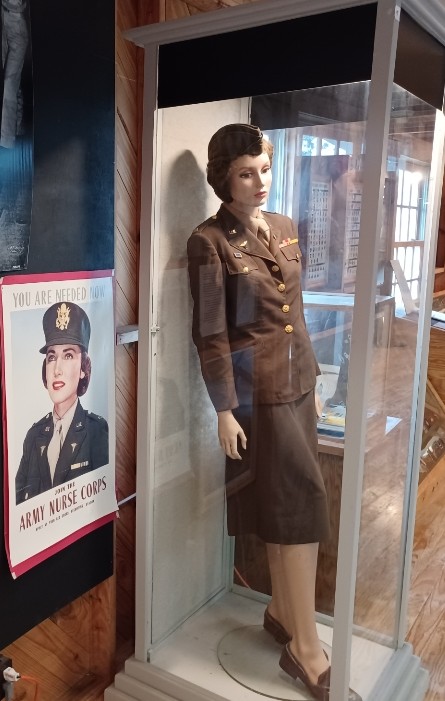Dr. Jerry Sanson
Louisiana Maneuvers and Military Museum
Members of the United States Army Nurse Corps played a significant role in World War II providing emergency care to wounded service men while working in unimaginably difficult circumstances. Army nurses experienced unprecedented levels of danger as they provided care under fire in field and evacuation hospitals, on evacuation trains and ships, and as flight nurses on medical transport airplanes. Their dedication and expertise led to a low post-injury mortality rate in the American military in every theater of the war. Less than 4 percent of American soldiers who received care in the field or were evacuated to a better-equipped facility away from the battlefront died from wounds or disease.
According to Army records, 942 women served in the Army Nurse Corps in June 1940 with an additional 15,700 in the Red Cross First Reserve, the traditional reserve and recruiting pathway for the Nurse Corps. The Red Cross recommended that the reservists volunteer for one year active duty in September 1940. Members responded as part of the patriotic duty felt by many Americans during the war, and the first Red Cross Reserve nurses were sworn in on October 8.
Nurses continued to volunteer for service during the war, and the Red Cross continued to advertise the military’s need for them using posters, magazine articles, and public speaking opportunities. President Franklin Roosevelt proposed a draft for nurses during his State of the Union address in January 1945, even though the Nurse Corps had a surplus of volunteers. The House of Representatives approved Roosevelt’s recommendation, the Senate dragged its feet, and President Harry Truman stopped legislative action on the proposal in May 1945.
University schools of nursing and training hospitals contributed to the number of nurses available for service by increasing the number of enrollment openings in their programs. The federal government played a role in increasing the number of nurses when Congress created the Cadet Nurse Corps in May 1943. The government paid the expenses of women who entered an accelerated program that reduced the time needed to become a nurse from three years to two and one-half years. Graduates had to commit to service in the Nurse Corps.
The Army did not initially require training beyond the traditional medical subjects that nurses studied, but added military training during 1943 when the first basic training center for nurses opened at Ft. Meade MD. Additional training centers opened during the war at Fort Devens, MA; Halloran General Hospital, Staten Island, NY; Camp McCoy, WI; and Brooke General Hospital, San Antonio, TX. Inductees received four weeks training in military courtesy and practices, sanitation, ward management, camouflage, the use of gas masks, and map reading. They also drilled and underwent physical training.
Flight Nurses received six to nine weeks specialized training because of the unique circumstances of evacuating patients by airplane who might be severely wounded. Their training program was initially located at Bowman Field in Louisville, KY, was renamed the School of Air Evacuation, and moved to Randolph Field, TX during 1943.
The danger that flight nurses were exposed to is illustrated by the experiences of Jane Kendeigh, the first Navy flight nurse to fly directly into a battlefield when her plane landed on Iwo Jima and came under artillery fire in March 1945. A month later, she also became the first flight nurse to land on Okinawa.
Nurses entered the Nurse Corps as second lieutenants, and most of them did not receive promotions from that rank. The chief nurse of a hospital was usually a first lieutenant, but sometimes a second lieutenant or a captain served in that capacity. The superintendent of the Nurse Corps held the rank of colonel, the highest rank of any Nurse Corps member.
More than 59,000 American nurses served in the Army Nurse Corps during World War II. Their service is remembered in the Nurse Corps exhibit located in the Louisiana Maneuvers and Military Museum because nurses as well as soldiers trained during the Maneuvers. The exhibit includes a Nurse Corps dress uniform, copies of two Nurse Corps recruiting posters, and a photograph of a nurse in flight uniform providing care for wounded soldiers during evacuation.

